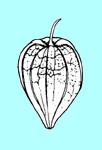 Line drawing by B. Osborn (Flora of Australia, vol. 29) . |
 From Britton & Brown (1898) An Illustrated Flora of the Northern States, Canada and the British Possessions (Charles Scribner's Sons). |

Synonymy
*Physalis ixocarpa Brot. ex Hornem., Suppl. Hort. Bot. Hafn. 26 (1819)
T: Cultivated in the Botanic Garden, Copenhagen, as a variety of P. angulata L.; iso: C, n.v., fide R.B. Fernandes, Bol. Soc. Brot. 44: 344–351 (1970).
See discussion by Bean in ASBS Newsletter 127: 7 (2006) on the name of this species.
Description
Annual to 50 cm, sparsely pubescent with minute, simple hairs, or glabrescent.
Leaves alternate, 1 or 2 per node (but not opposite); lamina ovate-lanceolate, cuneate at base, usually c. 6 cm long, 3 cm wide, sometimes larger irregularly toothed or lobed; petiole to 6 cm long.
Pedicels 6–10 mm long. Calyx 3.5–5 mm long; lobes triangular, 1–2 mm long. Corolla broadly stellate to 5–angled, 6–10 mm long, pale yellow with five dull brownish blotches. Anthers 1–1.5 mm long. Style 2–2.5 mm long. Fruiting calyx circular in section, 15–30 mm long, pale green when dry.
Berry globular, 11–14 mm diam. Seeds lens-shaped, 1.5–2 mm diam., yellow.
Distribution and ecology
Introduced species (c. 1925), now a widespread weed of cultivated areas in south-eastern Qld and eastern N.S.W. Usually associated with summer crops.
Common name
Ground Cherry, Tomatillo, Husk tomato
Selected specimens
Qld: Tummaville, C.T. White 12583 (BRI). N.S.W.: Glenfield, E.J. McBarron 20181 (NSW).
Derivation of epithet
From the Greek -carp = fruit. There are references to ixocarpa meaning "sticky fruit".
Images and information on web
Information on this species in NSW can be seen on the PlantNet site at http://plantnet.rbgsyd.nsw.gov.au/cgi-bin/NSWfl.pl?page=nswfl&lvl=sp&name=Physalis~ixocarpa
Background information and links to further references concerning P. ixocarpa can be found on the Plants for A Future database at http://www.ibiblio.org/pfaf/cgi-bin/arr_html?Physalis+ixocarpa&CAN=LATIND
An image of the flower, buds and leaves can also be seen at http://www.gartendatenbank.de/photo/2005080101 while information about the use of P. ixocarpa as Tomatillo or Husk tomato can be seen at www.tradewindsfruit.com/tomatillo.htm
Further information about the possible toxic properties of Physalis species can be found with a search in the FDA Poisonous Plant Database
Note: with the confusion surrounding the application of names in Physalis, information given on the web which is species specific should be viewed with some caution.